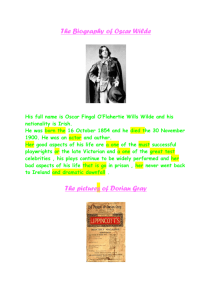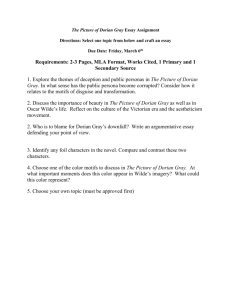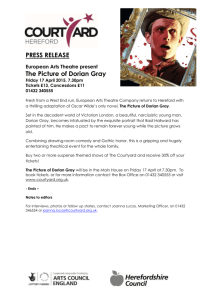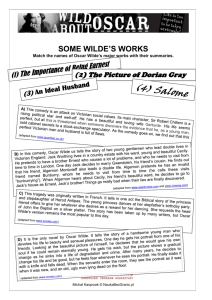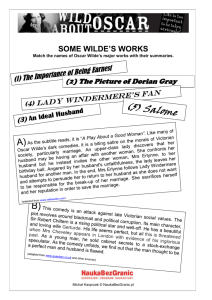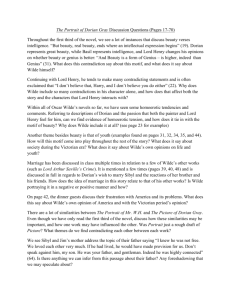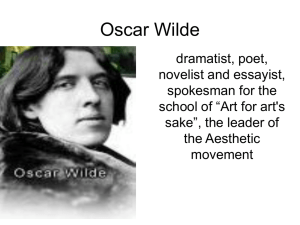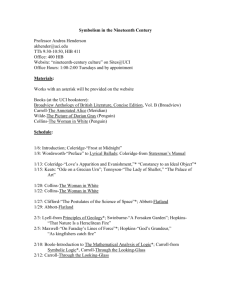Oscar Wilde draft lesson
advertisement
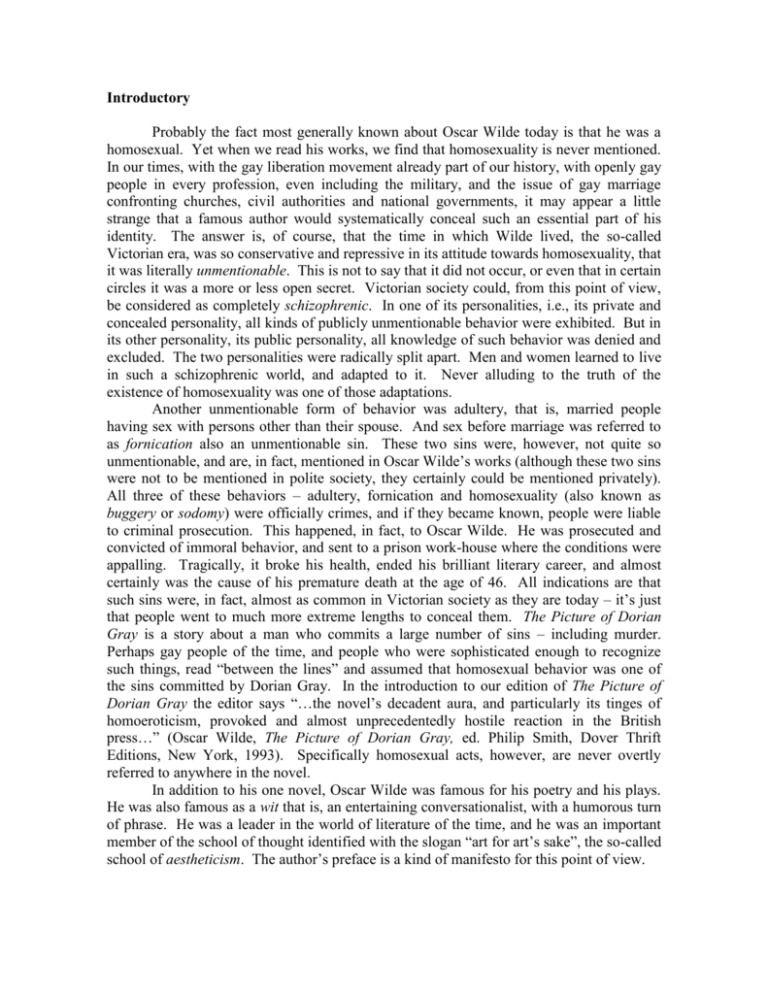
Introductory Probably the fact most generally known about Oscar Wilde today is that he was a homosexual. Yet when we read his works, we find that homosexuality is never mentioned. In our times, with the gay liberation movement already part of our history, with openly gay people in every profession, even including the military, and the issue of gay marriage confronting churches, civil authorities and national governments, it may appear a little strange that a famous author would systematically conceal such an essential part of his identity. The answer is, of course, that the time in which Wilde lived, the so-called Victorian era, was so conservative and repressive in its attitude towards homosexuality, that it was literally unmentionable. This is not to say that it did not occur, or even that in certain circles it was a more or less open secret. Victorian society could, from this point of view, be considered as completely schizophrenic. In one of its personalities, i.e., its private and concealed personality, all kinds of publicly unmentionable behavior were exhibited. But in its other personality, its public personality, all knowledge of such behavior was denied and excluded. The two personalities were radically split apart. Men and women learned to live in such a schizophrenic world, and adapted to it. Never alluding to the truth of the existence of homosexuality was one of those adaptations. Another unmentionable form of behavior was adultery, that is, married people having sex with persons other than their spouse. And sex before marriage was referred to as fornication also an unmentionable sin. These two sins were, however, not quite so unmentionable, and are, in fact, mentioned in Oscar Wilde’s works (although these two sins were not to be mentioned in polite society, they certainly could be mentioned privately). All three of these behaviors – adultery, fornication and homosexuality (also known as buggery or sodomy) were officially crimes, and if they became known, people were liable to criminal prosecution. This happened, in fact, to Oscar Wilde. He was prosecuted and convicted of immoral behavior, and sent to a prison work-house where the conditions were appalling. Tragically, it broke his health, ended his brilliant literary career, and almost certainly was the cause of his premature death at the age of 46. All indications are that such sins were, in fact, almost as common in Victorian society as they are today – it’s just that people went to much more extreme lengths to conceal them. The Picture of Dorian Gray is a story about a man who commits a large number of sins – including murder. Perhaps gay people of the time, and people who were sophisticated enough to recognize such things, read “between the lines” and assumed that homosexual behavior was one of the sins committed by Dorian Gray. In the introduction to our edition of The Picture of Dorian Gray the editor says “…the novel’s decadent aura, and particularly its tinges of homoeroticism, provoked and almost unprecedentedly hostile reaction in the British press…” (Oscar Wilde, The Picture of Dorian Gray, ed. Philip Smith, Dover Thrift Editions, New York, 1993). Specifically homosexual acts, however, are never overtly referred to anywhere in the novel. In addition to his one novel, Oscar Wilde was famous for his poetry and his plays. He was also famous as a wit that is, an entertaining conversationalist, with a humorous turn of phrase. He was a leader in the world of literature of the time, and he was an important member of the school of thought identified with the slogan “art for art’s sake”, the so-called school of aestheticism. The author’s preface is a kind of manifesto for this point of view. Life of Oscar Wilde Oscar Wilde was an upper-class Irishman, born in Dublin in 1854. His parents were both highly educated and were both published authors – his father having published books on folklore, archeology, and Jonathan Swift, while his mother was a well-known poet. He was educated at Trinity College, Dublin (1871-74) and from there went to Magdalen College, Oxford (1874-78). He studied the classics, and his admiration for ancient Greek civilization was an important formative element in his aesthetic point of view. He began writing poetry and won an important poetry prize at Oxford. In 1881 he published Poems (but at his own expense). In 1882 he went on a lecture tour of the United States and Canada, in which he promoted the point of view of the aestheticists, exhorting the public to prize art and beauty. In America, as at home in Britain, many people perceived his attitude and image as effeminate, and he was criticized and made fun of for this reason. His tour was, however, generally successful, and when he returned to Britain he lectured successfully about his experiences in America. He became a reviewer, and then a magazine editor and, in 1888 published a collection of fairy tales, The Happy Prince and Other Tales. Wilde was married in 1884, and two children were born of the marriage, in 1885 and 1886. Wilde’s most important works – The Picture of Dorian Gray and his dramas – were written in the last ten years of his life. His dramas were mostly so-called “society dramas” depicting the life-styles of the English upper classes, light and comic in nature. They are what you might expect in the way of drama from a brilliant conversationalist such as Wilde. The dialogue is witty and brilliant, just as Wilde himself was witty and brilliant. Most critics judge them to be very well constructed and dramatically effective, and they were well received by the theatre-going public. He wrote one play which did not fall into the category of “society drama” This was the play Salome which told the bible story of Salome, daughter of Herod, the king of the Roman province of Judea (the same Herod who sought to kill the infant Jesus, according to the account in the bible). It is recounted that she lusted after John the Baptist, the prophet of the coming of Christ, and when he refused her she had him beheaded, and his head brought to her on a plate. It is similar to The Picture of Dorian Gray in its fascination with sin and cruelty. It was written in French, and shows that Wilde must have had an excellent command of that language, among his other talents. An English translation was later published and was illustrated by a series of blackand-white woodblock prints by the English artist, Aubrey Beardsley. This series of prints became very famous subsequently, and were probably known by a much larger public than the original play. The play itself was not performed until much later. Rehearsals were in progress for the play when it first came out, but they were stopped by the British censor. If it had come out at the time it would, no doubt, have scandalized the Victorian public. Wilde’s two years of imprisonment (1895-97) were the result of a legal battle with an older English nobleman, The Marquess of Queensberry. This gentleman was furious because of the close friendship between his son, Lord Alfred Douglas, and Oscar Wilde. He hated Wilde for what he perceived as his immoral life style, and eventually succeeded in having Wilde imprisoned for sodomy (i.e., homosexual behavior). Wilde spent two years in a prison workhouse, where he was put to work on a treadmill, a particularly brutal form of forced labor. When he emerged from prison, he was bankrupt and broken in spirit. He went to live in Paris, where he hoped to regain his health and regenerate his literary career. In fact, in this period of his life he produced only one work, a long poem entitled The Ballad of Reading Gaol. Reading Gaol (gaol = jail) was the name of the prison where he had spent his two-year sentence, and the subject of the poem was the nature of life there. In 1900, probably due to his weakened state of health, he contracted an infection which resulted in meningitis, and caused his death. There is an excellent movie dramatization of the life of Oscar Wilde, (called Wilde) in which all these events are depicted. The Picture of Dorian Grey The Picture of Dorian Gray is Oscar Wilde’s only novel, and is unique in English literature. Like his theatre, it is filled with the witty conversation of educated English upper class characters, all of whom are wealthy enough to devote themselves to their personal interests in life – art, theatre, philanthropy, and the pursuit of pure pleasure. This society has been characterized as decadent. The word is commonly used in history to describe societies which reached a peak of power and influence through the vigorous efforts of virtuous, patriotic and conservative men and women, and then, because the society was so prosperous and life was so easy, went into a period of decline, particularly moral decline. It is a word often used in reference to the later Roman Empire. Intellectuals and historians throughout European history were fascinated by the enormous power of the Roman Empire, and endlessly curious about the reasons for its decline and disappearance. One of the most famous books in the English language is The Decline and Fall of the Roman Empire written in the eighteenth century by Edward Gibbon. At the time of Oscar Wilde’s literary activity, there was a generally acknowledged sense of danger that Britain (and western society generally) had already passed its peak of power and influence, and was entering a state of decadence which would lead to its destruction, just as in the case of Rome. A sign of this decadence, often pointed out by social commentators, was the aimless and pleasure seeking lifestyle of the idle rich. The Picture of Dorian Gray can be read as a criticism of this lifestyle, and a warning about the danger of the pursuit of pleasure. Critics have generally rejected this interpretation, however, as too simple. One reason for this is that, as the author of Dorian Grey, Wilde seems to take enormous pleasure in describing the beauties and advantages of such a lifestyle. His criticism of it seems obvious and shallow, while his praise of it is subtle and enchanting. The novel opens in a kind of paradise, with birds, flowers and gentle, warm breezes. How attractive is this decadent earthly paradise! Here are the opening two paragraphs of Dorian Gray: The Studio was filled with the rich odour of roses, and when the light summer wind stirred amidst the trees of the garden there came through the open door the heavy scent of the lilac, or the more delicate perfume of the pink-flowering thorn. From the corner of the divan of Persian saddle-bags on which he was lying, smoking, as was his custom, innumerable cigarettes, Lord Henry Wotton could just catch the gleam of the honey-sweet and honey-coloured blossoms of a laburnum, whose tremulous branches seemed hardly able to bear the burden of a beauty so flamelike as theirs; and now and then the fantastic shadows of birds in flight flitted across the long tussore-silk curtains that were stretched in front of the huge window, producing a kind of momentary Japanese effect, and making him think of those pallid, jade-faced painters of Tokio who, through the medium of an art that is necessarily immobile, seek to convey the sense of swiftness and motion. The sullen murmur of the bees, shouldering their way through the long, unmown grass, or circling with monotonous insistence round the dusty gilt horns of the straggling woodbine, seemed to make the stillness more oppressive. The dim roar of London was like the burdon note of a distant organ. Roses, lilac, pink-flowering thorn, laburnum, straggling woodbine, all are names of flowers whose scent is born on the “light summer wind” to the nostrils of the languid aristocrat taking his ease on the divan (divan is an old word for “sofa”). The furnishings are rich, and come from far corners of the British trading empire of Victorian times – the divan is made up of saddle-bags from Persia (present-day Iran) and are no doubt covered with the beautiful multi-coloured carpet material for which that region is famous throughout the world. The curtains are a kind of silk from India, called tussore. Lord Wotton is, like Oscar Wilde himself, a connoisseur of such beautiful materials, and a highly knowledgeable connoisseur of the arts. Stimulated by the momentary shadows of the birds on the silk curtains, he dreamily recalls the painters and print-makers of nineteenth century Japan. Two of these painters were Hiroshige and Hokkusai, known mostly through the wood-block prints they designed, which were imported in large numbers to Victorian Britain (to this day, the Victoria & Albert Museum in London houses one of the best collections in the world). They specialized in landscapes, and were particularly good at capturing effects of motion – wind, wind blown birds, kites, and even hats and umbrellas, driving rain, rivers and boats. The most famous image from their time is Hokkusai’s Wave an image of a huge, white capped breaking wave, with a diminutive boat and crew seemingly about to be enveloped and thrown headlong by the violence of the wave’s motion. (It is often seen on modern-day T-shirts, sometimes with the figure of a surfer on a surfboard replacing the original boat.) It was this type of connoisseurship of the finer things of life and appreciation of the arts that Wilde exhorted his American audiences to emulate, and which was prized by the school of Aestheticism to which Wilde belonged. Wilde may well have resembled Sir Henry Wotton, as he appears in the novel – certainly Sir Henry is much like Wilde in his talent for witty conversation. Below is a brief description of Sir Henry’s conversational expertise. It takes place at a luncheon at the home of an aristocratic aunt of Wotton’s. The lunch is accompanied by wine, and the spirit of the wine enlivens the atmosphere and invigorates Sir Henry’s nimble tongue. Wotton is knowledgeable in the classics (as was Wilde), pictures himself in terms of the ancient Greek devotees of wine. Bacchus was the god of wine, and his female followers were called bacchantes. Their habit was to wander in bands around the wild countryside, drinking and dancing wildly. They are often pictured accompanied by Silenus an old man riding a donkey who, himself drunk, follows them in their drunken revels. Another reference in the passage below is to Omar Khayyam, a Persian poet who sang the praises of wine, love and pleasure, and is pictured here sitting at the winepress, where the grapes are pressed into juice for making wine: He played with the idea, and grew willful; tossed it into the air and transformed it; let it escape and recaptured it; made it iridescent with fancy, and winged it with paradox. The praise of folly, as he went on, soared into a philosophy, and Philosophy herself became young, and catching the mad music of Pleasure, wearing, one might fancy, her wine-stained robe and wreath of ivy, danced like a Bacchante over the hills of life, and mocked the slow Silenus for being sober. Facts fled before her like frightened forest things. Her white feet trod the huge press at which wise Omar sits, till the seething grape-juice rose around her bare limbs in waves of purple bubbles, or crawled in red foam over the vat’s black, dripping, sloping sides. It was an extraordinary improvisation. He felt that the eyes of Dorian Grey were fixed on him, and the consciousness that amongst his audience there was one whose temperament he wished to fascinate, seemed to give his wit keenness, and to lend colour to his imagination. He was brilliant, fantastic, irresponsible. He charmed his listeners out of themselves, and they followed his pipe laughing. Dorian Gray never took his gaze off him, but sat like one under a spell, smiles chasing each other over his lips, and wonder growing grave in his darkening eyes. Wilde here pictures the flight of conversation in musical terms. He uses the word “improvisation”, often used in classical music (and later in jazz), meaning a free invention by the performer, not played from a previously written musical score. And Wotton is pictured as a kind of “pied piper” The Pied Piper of Hamelin is a story from the German collection of fairy tales by the brothers Grimm, and tells the story of a piper (i.e., a flutist) whose magic flute is able to charm living creatures, and make them follow him anywhere. It is obvious that, in conversation, Lord Wotton had a similar talent. Given Wilde’s reputation as a conversationalist, it must have been quite impressive to see him “perform” the way Lord Wotton does in our story. To return to our discussion of the opening scene of the story: it is not at all clear that Wilde is to be wholly identified with Sir Henry Wotton. The artist, Basil Hallward, can also be seen as representing Wilde himself. That the opening scene takes place in the artist’s studio is surely a way of establishing, from the very beginning, art, the artist’s relationship with his work, and with his subject (in this case, the beautiful young Dorian Gray), as a central concern of the story. Wilde also paints a picture of Dorian Grey – a picture in words. Hallward is a man devoted to his art. And the picture of Dorian Gray is, according to him, the culmination of his art – he feels he will never be able paint anything that beautiful again. And because this picture is, to himself, so extraordinary, he decides he does not want others to view it, and that he will not, therefore send it out to be exhibited. His conversation with Lord Wotton about it is rather curious: (Lord Henry says:) “…I want you to explain to me why you won’t exhibit Dorian Gray’s picture. I want the real reason.” “I told you the real reason.” “No, you did not. You said it was because there was too much of yourself in it. Now, that is childish.” “Harry,” said Basil Hallward, looking him straight in the face, “every portrait that is painted with feeling is a portrait of the artist, not of the sitter. The sitter is merely the accident, the occasion. It is not he who is revealed by the painter; it is rather the painter who, on the coloured canvas, reveals himself. The reason I will not exhibit this picture is that I am afraid that I have shown in it the secret of my own soul.” (p.4) Despite Basil Hallward’s conviction that the picture reveals the secrets of his soul, as the story plays out, we discover that, actually, the picture reveals the secrets of Dorian Gray’s soul, and faithfully records the changes and corruptions in that soul over the next twenty years or so. Is Dorian Gray, perhaps a kind of alter ego for Hallward, a living embodiment of the artist’s soul? Does Wilde hint that Dorian Grey is, similarly, a creation who reveals the secrets of his (Wilde’s) soul? In any event, it is clear that this relationship between the artist and his creation is a major theme of the book. There are two stories from Greek mythology which have correspondences with the story of Dorian Gray: the stories of Narcissus and of Pygmalion. There is no doubt that Wilde would have been very familiar with these stories, and little doubt that he would have expect educated readers of his time to be reminded of them, when reading the story of Dorian Gray. Narcissus was the son of a river god, and was distinguished for his great beauty. He caught sight of his own image in the waters of a spring, fell in love with that image, and, since he could find no way to possess it, pined away and died. Pygmalion was a sculptor who made an ivory statue of a woman that was so beautiful that he fell in love with it. In answer to his prayers, the goddess Venus brought the statue to life. (A little after Wilde’s time George Bernard Shaw wrote a comic modern-day version of the Pygmalion story, and this is the story used to make the popular broadway musical My Fair Lady.) The Narcissus story is overtly mentioned a couple of times in the novel. On one occasion, Dorian speculates about the changes that will gradually mar the perfection of the painted image of himself: He felt that the time had really come for making his choice. Or had his choice already been made? Yes, life had decided that for him – life, and his own infinite curiosity about life. Eternal youth, infinite passion, pleasures subtle and secret, wild joys and wilder sins – he was to have all these things. The portrait was to bear the burden of his shame: that was all. A feeling of pain crept over him as he thought of the desecration that was in store for the fair face on the canvas. Once, in boyish mockery of Narcissus, he had kissed, or feigned to kiss, those painted lips that now smiled so cruelly at him. Morning after morning he had sat before the portrait wondering at its beauty, almost enamoured of it, as it seemed to him at times. Was it to alter now with every mood to which he yielded? Was it to become a monstrous and loathsome thing, to be hidden away in a locked room, to be shut out from the sunlight that had so often touched to brighter gold the waving wonder of its hair? The pity of it! The pity of it! (p. 77) Basil Hallward reminisces over the various ways he had painted Dorian Gray, before painting the final portrait which is the subject of the story. He had painted Dorian as a series of classical and mythological figures, including Narcissus. As he tells Dorian: "You had leant over the still pool of some Greek woodland, and seen in the water's silent silver the marvel of your own face." (p. 83) Hallward, the artist, is certainly in love with his own creation, the picture of Dorian Gray. On the other hand, he seems even more in love with the beautiful young Dorian Gray himself; indeed, when he feels that a quarrel over the ownership of the picture will endanger their friendship, he picks up a knife and attempts to destroy it – only to be stopped by Dorian Gray himself, who seizes the knife from him and flings it away. Perhaps the novel itself is the real picture, a beautiful creation that is immune from the ravages of time – an ideal creation but based upon life in the flesh, and an incarnation of love for the ideals of beauty and youth – but also of love for a beautiful young man. Another story from mythology (this time, from medieval European mythology) which seems to hover in the background of the story of Dorian Gray is the story of Faust. Faust is said to have sold his soul to the devil in exchange for worldly success and power. It was a popular story in medieval Europe, and was made into a successful stage play in England around the time of Shakespeare (Doctor Faustus by Christopher Marlowe). Based on this story, the great eighteenth century German poet, Goethe, wrote the verse-drama Faust, the most famous work of German literature. In Goethe’s story the devil is given the name Mephistopheles and his character shows a certain similarity to that of Lord Henry Wotton in our story. It is Lord Henry who puts the fear of growing old and unattractive into the mind of the young Dorian Gray. Then comes a moment in the story where the young Dorian declares himself ready to make the same kind of pact with the devil that Faust made: “How sad it is!” murmured Dorian Gray, with his eyes still fixed upon his own portrait. “How sad it is! I shall grow old, and horrible, and dreadful. But this picture will remain always young. It will never be older than this particular day of June…If it were only the other way! If it were I who was to be always young, and the picture that was to grow old! For that – for that – I would give everything! Yes, there is nothing in the whole world I would not give! I would give my soul for that!” It seems that, at that moment, the devil accepts the offer from the young Dorian Gray (although this does not become clear until later, when Gray sees the picture beginning to change). From then on Dorian Gray’s soul is given over to the devil – to “sin” and corruption, while he retains his marvelous youth, and the portrait ages and becomes ugly. He also leads a charmed life, and repeatedly escapes being unmasked or punished for his crimes (this, one suspects, is the devil’s work). This magical, or supernatural phenomenon, whereby the ravages of time and evil appear on the face of the portrait, while the hero retains his youthful beauty, put The Picture of Dorian Gray in the tradition of the so-called gothic novel. The original “gothic novels” from the late 1700’s were set in the middle ages and the action took place in castles and other settings of medieval or gothic architecture. They projected a dark and mysterious atmosphere and often used supernatural elements in their plots. They are the ancestors of today’s horror stories and films. The Portrait of Dorian Gray, since its plot hinges on a supernatural phenomenon, certainly qualifies as part of the gothic tradition. However, most of the novel takes place in a light, often sunny atmosphere and the gothic elements while present, do not really dominate. The principal and memorable atmosphere of the novel is light and airy. The dark elements seem grafted on and, perhaps, a little artificial. The "sins" that are attributed to Dorian seem to be mainly drinking, womanizing and occasional indulgence in opium. The "sinful" acts themselves are never really specifically described or recounted. We are left to imagine them from the apparent shame of those who are known to have been involved with Dorian, and the disapproving attitude of those familiar with his bad reputation. Did they include homosexual behavior? Certainly nothing along those lines is actually mentioned anywhere in the book. Even if it were, by modern standards, Dorian is hardly a really significant sinner. The one crime of his that is described in the book, the murder of Basil Hallward, is an unpremeditated flash of passion. From the perspective of Victorian times, probably the most serious crime ascribed to Dorian is the ruining of people's reputations – and this probably was, indeed, a very serious business in English upper class society of the Victorian era. From Wilde's description of the changes that take place in the picture, the most important sin is that of cruelty. The first change in the picture occurs after Dorian heartlessly abandons the innocent Sibyl Vane, who loves Dorian so completely that she commits suicide when she realizes she has lost him (and Dorian, after a brief period of sadness and regret, returns to his pursuit of pleasure almost immediately). Dorian discovers the change in the picture when he returns home in the early morning, after spurning Sibyl: …As he was turning the handle of the door, his eye fell upon the portrait Basil Hallward had painted of him. He started back as if in surprise. Then he went on into his own room, looking somewhat puzzled. After he had taken the buttonhole out of his coat, he seemed to hesitate. Finally he came back, went over to the picture, and examined it. In the dim arrested light that struggled through the cream-coloured silk blinds, the face appeared to him a little changed. The expression looked different. One would have said that there was a touch of cruelty in the mouth. It was certainly strange. He turned round, and, walking to the window, drew up the blind. The bright dawn flooded the room, and swept the fantastic shadows into dusky corners, where they lay shuddering. But the strange expression that he had noticed in the face of the portrait seemed to linger there, to be more intensified, even. The quivering, ardent sunlight showed him the lines of cruelty round the mouth as clearly as if he had been looking into a mirror after he had done some dreadful thing. He winced, and, taking up from the table an oval glass framed in ivory Cupids, one of Lord Henry's many presents to him, glanced hurriedly into its polished depths. No line like that warped his red lips. What did it mean? (p. 65-66) Dorian's cruelty is mentioned subsequently on various occasions, often in connection with the changes visible in the portrait. It seems that if Wilde is implicitly condemning any sin, it must be the sin of cruelty. On the surface, the story is a gothic tale of crime and punishment, a moral tale, and a warning against selfish and hedonistic behavior. Wilde, however, prefaced the book with an aesthetic statement, and in this statement he specifically contradicts the notion that a work of art should have a moral or didactic purpose. Here is a little of what he says: The artist is the creator of beautiful things. To reveal art and conceal the artist is art's aim. … There is no such thing as a moral or an immoral book. Books are well written, or badly written. That is all. … The moral life of man forms part of the subject-matter of the artist, but the morality of art consists in the perfect use of an imperfect medium. … No artist has ethical sympathies. An ethical sympathy in an artist is an unpardonable mannerism of style. No artist is ever morbid. The artist can express everything. Thought and language are to the artist instruments of an art. Vice and virtue are to the artist materials for an art.(p. vii) If we take Wilde’s preface as a frank statement of his intentions as an artist, we must assume that the gothic tale, with its rather obvious moral meaning – i.e., it’s warning about sin and the dangers of the pleasure-seeking life – is just a device, a frame in which is painted the true subject of the book: the alluring young man Dorian Gray. Is Wilde, the artist, just as did Basil Hallward, revealing in the portrait the secrets of his soul? Is one of those secrets the idolatrous love of a beautiful young man? Was that young man, perhaps, Lord Alfred Douglas, the man for whose sake Wilde was eventually imprisoned? It’s hard to say: The artist is the creator of beautiful things. To reveal art and conceal the artist is art’s aim.
